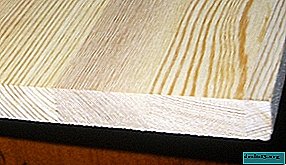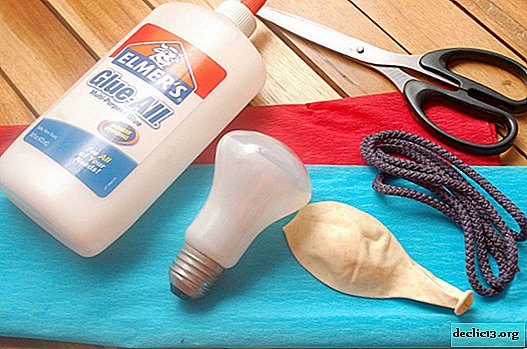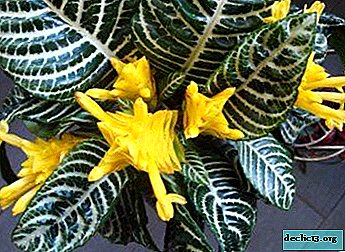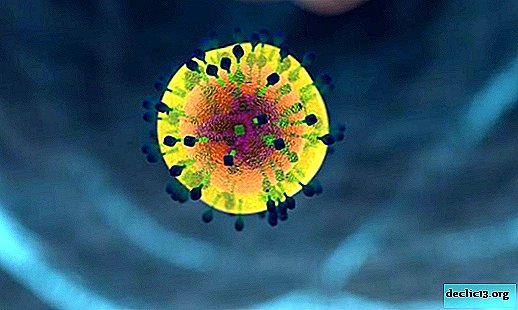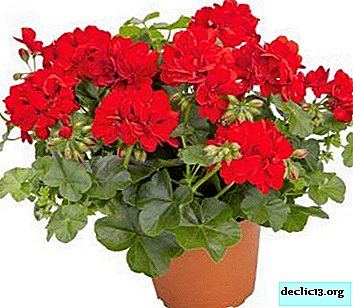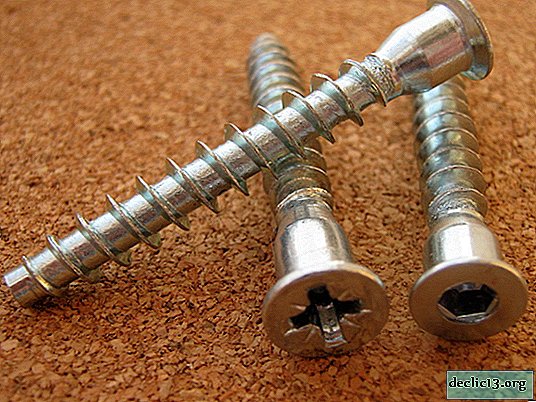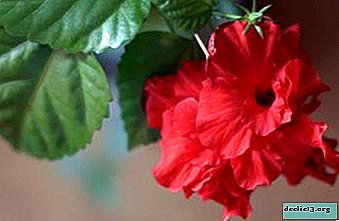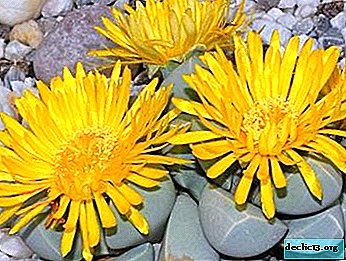Impatiens on the windowsill, or all about the pink balsam Tom Samb: features, care, illness, as well as a photo
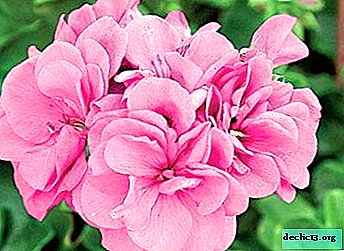
The Balsamino family has gained worldwide popularity in gardening due to its chic, bright, saturated colors.
Some people call these plants - “lights” - for their attractive floral arrangement, which you simply cannot pass by.
To date, breeders have bred more than 600 species of this family. And one of the brightest representatives of balsam is the variety Tom Samb - an elegant plant with large double flowers. In this article, we will consider in detail about a unique and truly beautiful indoor plant - balsam pink samb som, as well as learn how to properly care for, protect from pests and much more.
Botanical Description and Origin
Balsam is an annual herbaceous plant reaching a stem height of 20-75 cm (as stated by breeders, although in fact it can grow even higher). The national name is touchy balsamic because of its sensitivity to the slightest touch, after which the buds of this plant seem to “explode”.
First imported from China, but perfectly adapted to living conditions in mid-latitudes. The foliage of the pink balsam Tom Samb is thick and elongated, and the flowers take on a soft pink shade with a terry effect, with a diameter of up to 7 cm.
The flowering period is quite long: from the beginning of summer to the first frosts. The stems are slightly watery, which makes them fragile. The bush itself has a compact appearance.
Reference! Later, the growth of this flower in natural nature was found even in the tropics and subtropics of Africa, Asia, and also North America.Appearance and features
Shoots have a branched, translucent appearance. Their color is dominated by light green. The leaves are located on the stem opposite each other and have a heart-shaped shape. Petioles, by which leaves are attached to the shoot, are very fragile, so you should be extremely careful when handling Balsam. The petals on the buds are widely opened, due to which the general appearance of the flower becomes even more grandiose.
A feature of pink balsam is its intransigence with home living conditions. This is a free plant, and in the room its growth goes only up, because the flower stretches to the nearest light source. As a variant of a home plant, it is recommended to place it on open loggias.
Photo
Below you can find a photo of the pink balsam Tom Samb.




Landing tips
Planting seeds or sprouted seedlings in open ground is necessary not earlier than the moment when the soil warms up to 19-23 degrees above zero.
How to prepare the ground?
- Before placing the seeds in the soil, it must be properly treated with a solution that protects the planting material from fungal attacks.
- Prepare the soil yourself. For this you need coarse sand and peat, taken in equal proportions. The earth should be sufficiently moist and neutral acidity.
- Dilute the finished soil with humus or other disintegrating substances in order to reduce the density of the soil. With this composition, you do not need to fertilize the soil (humus has already completed this mission), because from an overabundance of nutrients, balsam can respond to you by dropping the leaves.
Which place to choose?
Finding the right place to plant Balsam in your garden should be taken seriously.
Impatiens well take root in sunny or semi-darkened areas. An ideal place would be in which a shadow will form from noon to 3 p.m. (that is, during the period when the sun's rays have the most negative effect on living organisms). Some gardeners recommend planting pink Tom Samb near trees with a rare crown or on the northwest and northeast sides of any structures.
Make sure that the place you choose is free of drafts and strong winds that can break the fragile shoots of the flower.
Care
Watering
 Oily stalks of the “evergreen” need regular and quite plentiful watering, otherwise, otherwise Balsam will begin to show signs of moisture deficiency (drying of leaves and loss of color).
Oily stalks of the “evergreen” need regular and quite plentiful watering, otherwise, otherwise Balsam will begin to show signs of moisture deficiency (drying of leaves and loss of color).
If measures are not taken in time, the foliage and buds will disappear altogether. Watering the plant is advised after sunset. The flower will not refuse from spraying, but in order not to burn the leaves, this should also be done after sunset.
Beware of water droplets falling on the buds, which, due to excess fluid, may lose their decorative effect.
Lighting
About the exactingness of the Touch of Lighting, we wrote above. If you planted a flower without knowing these details, then save the plant by replanting shrubs or shrubs that will not only create a shadow, but also form a beautiful floral arrangement.
Lack of light will turn around:
- stretching the shoots;
- lack of flowering;
- reducing the size of the foliage and the loss of their brightness.
Top dressing
Regular fertilizer of Balzamin will help strengthen his health and chic appearance. You need to feed the complex, the basis of which is potassium and phosphorus. This procedure must be carried out every two weeks. Exclude nitrogen from the list of fertilizers. Enough is the amount of this element that you introduced into the ground before planting.
Of course, after applying a large dose of nitrogen, you will be able to observe abundant planting, however, the flowering activity will become much less.
Pests and diseases
We describe the common diseases of Balzamin in the form of a “question-answer”.
- Why do the leaves fall?
This type of ailment is found in many representatives of this family. This is due to lack of lighting or too low air temperature. Sometimes the cause may be a rare soil moisture. Pay attention to these factors and adjust them. - Why does foliage curl?
Most often, this signals an attack of multi-clawed or spider mites. Get rid of the affected parts of the flower, and treat the rest with a special tool. - Why do leaves turn yellow?
The loss of green shade of foliage is associated with insufficient watering. To prevent the entire flower from dying, adjust the frequency of watering. - Why do buds fall?
Sometimes this happens during the period of plant adaptation after purchase or transplantation. But it happens that the root of the problem may be hiding in the drying out or waterlogging of the soil. - Why do the leaves dry?
There is only one answer - there is not enough moisture in the soil. Water the plant more often. - Why are shoots drawn out?
To stop the growth of stems in height, you need to move Balsamin to a more lighted and cool place. - Why is Not Touchy blooming?
The reason lies in poor lighting and insufficient fertilizer. Still such an ailment may occur due to hypothermia. Try to provide the plant with the right amount of light and complex nutrients.
Viruses
The most common viral disease in this plant is gray rot. It appears due to excessive watering and excessively humid air and is characterized by drying and falling of flower buds. To prevent rhizomes from decaying, transplant, if possible, a plant to a new place with a different soil composition and do not violate the irrigation regime.
Arthropods
- Spider mite.
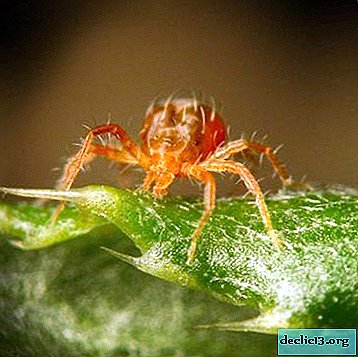 It is characterized by the appearance of yellow blotches on the surface of the sheet plate. This pigmentation over time can take on a larger scale and is transformed into large spots.
It is characterized by the appearance of yellow blotches on the surface of the sheet plate. This pigmentation over time can take on a larger scale and is transformed into large spots.Usually the cause of this parasite is dry and hot air. Therefore, to avoid this problem, spray the flowers as often as possible. To overcome the spider mite, the affected parts of the flower must be removed. With light infections, you can not get rid of the plant, but try to save it by treatment with a soapy solution.
- Whitefly
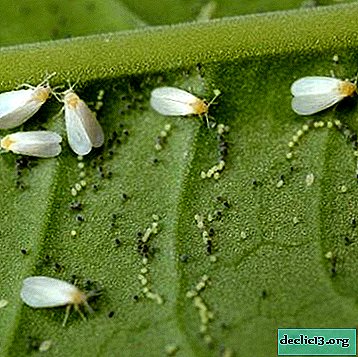 This pest can be noticed by yellowed leaves and the appearance of a sticky discharge on them. And you can observe the whitefly itself on the foliage of balsam.
This pest can be noticed by yellowed leaves and the appearance of a sticky discharge on them. And you can observe the whitefly itself on the foliage of balsam.To get rid of it, they are treated with a solution based on potassium soap.
- Thrips.
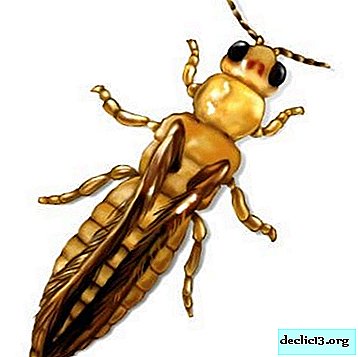 Young leaflets, which during their growth begin to deform, fall under the negative influence of thrips. If such pests are found on the “evergreen”, all affected parts must be removed immediately, since even after a short contact with these “dirty” plants, the plant can be completely destroyed.
Young leaflets, which during their growth begin to deform, fall under the negative influence of thrips. If such pests are found on the “evergreen”, all affected parts must be removed immediately, since even after a short contact with these “dirty” plants, the plant can be completely destroyed. - Multi-claw ticks.
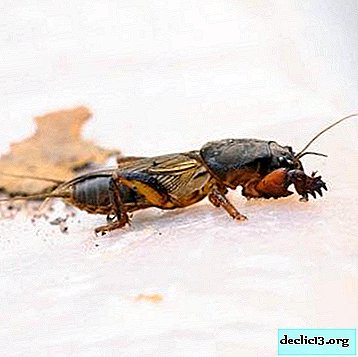 About these "infections" we have already mentioned in this article. Symptoms of their appearance are hardening and deformation of leaves, which practically stop their growth. The reason for the appearance of this species of ticks is too high temperature and humidity. To prevent infection, try to control these indicators.
About these "infections" we have already mentioned in this article. Symptoms of their appearance are hardening and deformation of leaves, which practically stop their growth. The reason for the appearance of this species of ticks is too high temperature and humidity. To prevent infection, try to control these indicators.
Breeding
Impatiens easily reproduces in two ways:
- Cuttings. To obtain cuttings, the upper parts of shoots are cut about 8 cm long. This procedure can be carried out even during the period of bud growth. The rooting of the shoots is allowed both in water and immediately in the soil prepared from a mixture of peat and sand. In a week, the cuttings will take their first roots. This method of reproduction is more popular than seed, because of the rapid development and relatively early flowering.
- The seeds. But Balzamin planted from seeds boasts of its flowers only 3-4 months after the first shoots. Before placing the seeds in the soil, they need to be treated with a fungicide solution to protect against fungal attacks.
It is recommended to plant seeds to a depth of 0.5 cm, observing a distance of 3-4 cm. After that, moisten the soil only with a spray gun so that the planted grains are not washed with a stream of water. For a faster shoot, cover the planted area with film or glass. But do not forget about the daily ventilation of the greenhouse. The first natives will appear from the earth in just 10 days.
The unpretentious Balzamin has long taken its place of honor among the flowers that adorn almost every garden plot. Drop Vanka Wet and you, and we are sure, will never regret the time or energy spent or the money spent.

 It is characterized by the appearance of yellow blotches on the surface of the sheet plate. This pigmentation over time can take on a larger scale and is transformed into large spots.
It is characterized by the appearance of yellow blotches on the surface of the sheet plate. This pigmentation over time can take on a larger scale and is transformed into large spots. This pest can be noticed by yellowed leaves and the appearance of a sticky discharge on them. And you can observe the whitefly itself on the foliage of balsam.
This pest can be noticed by yellowed leaves and the appearance of a sticky discharge on them. And you can observe the whitefly itself on the foliage of balsam. Young leaflets, which during their growth begin to deform, fall under the negative influence of thrips. If such pests are found on the “evergreen”, all affected parts must be removed immediately, since even after a short contact with these “dirty” plants, the plant can be completely destroyed.
Young leaflets, which during their growth begin to deform, fall under the negative influence of thrips. If such pests are found on the “evergreen”, all affected parts must be removed immediately, since even after a short contact with these “dirty” plants, the plant can be completely destroyed. About these "infections" we have already mentioned in this article. Symptoms of their appearance are hardening and deformation of leaves, which practically stop their growth. The reason for the appearance of this species of ticks is too high temperature and humidity. To prevent infection, try to control these indicators.
About these "infections" we have already mentioned in this article. Symptoms of their appearance are hardening and deformation of leaves, which practically stop their growth. The reason for the appearance of this species of ticks is too high temperature and humidity. To prevent infection, try to control these indicators.
